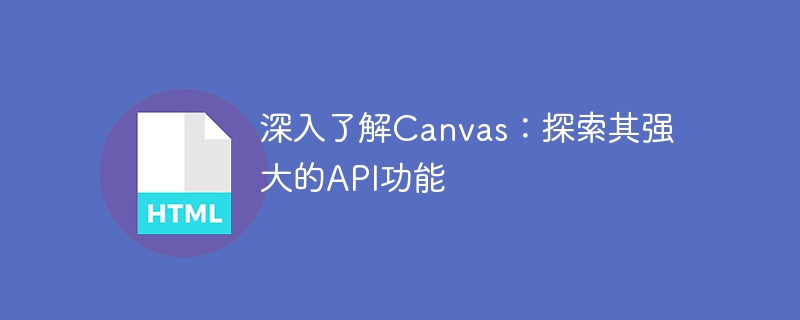

In-depth understanding of Canvas: To explore its powerful API functions, specific code examples are required
Introduction:
Canvas is an important element in the HTML5 standard. It provides The developer provides an area where graphics can be drawn using JavaScript. Through simple HTML code and JavaScript code, developers can achieve a variety of dazzling graphics, animations and interactive effects. This article will explore the powerful API capabilities of Canvas in depth and provide some specific code examples.
1. Create Canvas element
Creating a Canvas element in HTML is very simple, just add a
<canvas id="myCanvas" width="500" height="500"></canvas>
The above code creates a Canvas element with a width of 500 pixels and a height of 500 pixels, and assigns an id attribute.
2. Obtain the context of Canvas
In JavaScript, to draw on Canvas, you need to obtain its context object first. The drawing context can be obtained through the getContext() method of Canvas. The code is as follows:
var canvas = document.getElementById("myCanvas");
var ctx = canvas.getContext("2d");In the above code, the Canvas element with the id "myCanvas" is obtained through the document.getElementById() method, and then the Canvas drawing context is obtained using the getContext() method and assigned to A variable ctx.
3. Draw basic shapes
ctx.fillStyle = "red"; ctx.fillRect(50, 50, 100, 100); ctx.strokeStyle = "blue"; ctx.strokeRect(200, 200, 150, 100);
The above code first uses the fillStyle attribute to set the color of the solid rectangle to red, and then uses the fillRect() method to draw a solid rectangle with a width and height of 100 pixels. Then use the strokeStyle property to set the color of the hollow rectangle to blue, and then use the strokeRect() method to draw a hollow rectangle with a width of 150 pixels and a height of 100 pixels.
ctx.beginPath(); ctx.arc(250, 250, 50, 0, Math.PI * 2); ctx.fillStyle = "yellow"; ctx.fill();
The above code first uses the beginPath() method to start a new path, and then uses the arc() method to draw a circle with a center at (250,250) and a radius of 50 pixels. Finally, use the fillStyle attribute to set the fill color to yellow, and use the fill() method to perform a solid filling.
4. Drawing images
Drawing images in Canvas is very simple, just use the drawImage() method. The code example is as follows:
var img = new Image();
img.src = "image.jpg";
img.onload = function() {
ctx.drawImage(img, 0, 0);
}The above code first creates an Image object and assigns the path of the image to the src attribute. Then listen to the image loading completion event through the onload event. When the image loading is complete, use the drawImage() method to draw the image. The position of the image is (0,0).
Summary:
This article introduces the basic use of Canvas, including creating Canvas elements, obtaining Canvas context, drawing basic shapes, and drawing images. Canvas provides rich API functions, and developers can achieve a variety of graphics and animation effects by skillfully using these APIs. We hope that the code examples provided in this article can help readers better understand the powerful functions of Canvas and apply them in actual development.
The above is the detailed content of A Deep Dive into Canvas' API Features: Discover Its Power. For more information, please follow other related articles on the PHP Chinese website!




